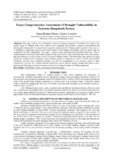| dc.contributor.author | Otieno, Richard J. | |
| dc.date.accessioned | 2020-01-29T16:53:56Z | |
| dc.date.available | 2020-01-29T16:53:56Z | |
| dc.date.issued | 2019-10 | |
| dc.identifier.citation | IOSR Journal Of Humanities And Social Science (IOSR-JHSS) Volume 24, Issue 10, Series. 12 (October. 2019) 65-72 | en_US |
| dc.identifier.issn | 2279-0837 | |
| dc.identifier.issn | 2279-0845 | |
| dc.identifier.uri | http://hdl.handle.net/123456789/4391 | |
| dc.description.abstract | This paper explores the vulnerability context in Turkana rangeland. It establishes the origin of the people living in Turkana before they settled in the rangeland and provides a general environmental and demographic background. It is argued that to properly understand how Turkana people respond to food crises, it is imperative to appreciate that given the hostile nature of the Turkana environment, there are factors that are responsible for their vulnerability. The paper is based on key informant and household interviews. This is complemented by local level information gathered from other sources such as informal interviews, observation, and case histories, as well as from a review of several Turkana studies. This knowledge may enable us to gain satisfactory insight into the challenges facing Turkana people in attempting to secure a reliable and sustained livelihood, and how their livelihood responses can best be strengthened. It also becomes easier to draw
comparisons with how the Turkana pastoral production systems function during „drought and famine stress‟threat period. The paper is based on extensive review of secondary literature on Turkana rangeland. | en_US |
| dc.language.iso | en | en_US |
| dc.subject | Vulnerability | en_US |
| dc.subject | famine | en_US |
| dc.subject | environment and demography | en_US |
| dc.title | Fuzzy Comprehensive Assessment of Drought Vulnerability in Turkana Rangeland, Kenya. | en_US |
| dc.type | Article | en_US |

